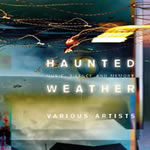|
|
 |
Dusted Reviews
Artist: V/A Album: Haunted Weather Label: Staubgold Review date: Jun. 10, 2004 |

|
|
|
 |
In 1995, veteran British musician and critic David Toop published a marvelous book called Oceans of Sound. Along with an accompanying compilation, Toop proved to be one of music’s most insightful writers insofar as he detached himself completely from concerns about genre in order to focus on texture, space, and affect. Training his keen ear on everything from vintage Sun Ra basement recordings to early AMM, from Napalm Death to Stockhausen, Toop investigated the ways in which rapidly changing culture and technology have transformed music-making and listening to the point where “sound (and music, in particular) has come to express this alternately disorientating and inspiring openness through all that is solid melts into aether.”
The two-disc Haunted Weather compilation accompanies Toop’s new book of the same name. I haven’t read it yet (though I certainly look forward to doing so), but based on the music included here it appears that Toop is continuing his explorations of technology, affect, and listening practices. Of particular interest is the recent restructuring of electronic music, specifically the advent of so-called electroacoustic improvisation (and its relationship to “standard” free improvisation as well as to new music composition and, for lack of a better term, pop music). Toop has selected a typically broad range of music, a variety which testifies not only to the wealth of exciting developments occurring across genres these days, but which wonderfully captures the intellectual questions he’s pursuing (and, as I and others have written frequently, one of the real pleasures of electroacoustic music – whether it’s AMM, Toshimaru Nakamura, or Trapist – is the way it confronts listeners with questions) as well.
But I reckon you don’t really need the book to enjoy this compilation (though you’ll most likely want to read it, if you’re the kind of listener who digs these selections). It stands on its own as a coherent, well-paced program, encompassing raucous mischief-making, tranced-out electronica/techno, and the sparser climes of “eai.” Duty dictates a complete track listing, I suppose. So, disc one includes Christian Marclay, Oval, Matmos, Terre Thaemlitz, Janet Cardiff, Peter Cusack, Yuko Nexus6, Sarah Peebles, Haco, Filament (Otomo Yoshihide/Gunter Muller/Sachiko M), Alvin Lucier, Evan Parker, Max Eastley and David Toop, Foldings (Tetuzi Akiyama/Toshi Nakamura/Taku Sugimoto/Mark Wastell), Tacita Dean Aden, the Spontaneous Music Ensemble, Tacita Dean, John Oswald, and Yurihito Watanabe. Disc two includes Autechre, Christian Fennesz, Ryoji Ikeda, Derek Bailey and John Stevens, Akio Suzuki, Chris Watson, Pan Sonic, John Butcher, Kaffe Matthews, Toshiya Tsunoda, Taku Sugimoto, David Cunningham, Carsten Nicolai and Ryuichi Sakamoto, Keith Rowe and John Tilbury, and Jem Finer. Whew!
Listening through this compendium is a pleasurable – and often challenging – aesthetic experience, but it also serves as a valuable (and quite Wire-like) primer on the state of electronics in contemporary music: There are excellent field recordings (the Watson and Tsunoda tracks will appeal to fans of Olivia Block), superb quasi-popular constructions (Autechre and Matmos, most obviously, but also the lush melodicism of Fennesz), and disorienting sounds seemingly loosed from any idiomatic association (Butcher, Foldings, Filament).
All tracks but a few are available elsewhere; some are quite well known (the Fennesz is from Endless Summer), while others are extremely obscure (the Aden or the Cardiff). Some are complete pieces, while others are excerpts from much longer performances. These disparities aside, there is good flow across the two discs and Toop’s programming keeps things moving, making sure that no aesthetic settles in for too long. Indeed, this is one of the motivations behind choosing the title: meteorology is obviously an inexact science at best. Not only is the current musical weather continually in flux, Toop is suggesting with his assemblage, it is also haunted by technological ghosts, spectres from the musical past, which pass through the walls and firm structures currently separating scenes, genres, and the like. Rather than serve as an embodiment of alienation, technology is used to, in Toop’s words, to “encourage new relationships to place, community and communication.” Starting a relationship with this fine compilation is a good way to embrace the climate change.
By Jason Bivins
|







